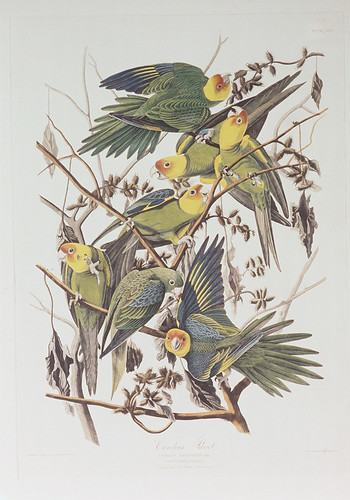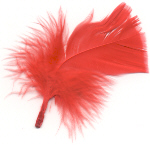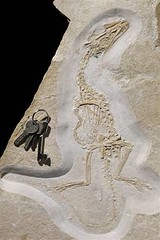
Carolina Parakeets, Conuropsis carolinensis, (also known as Carolina Conures)
Click image for much larger version in its own window.
Painting by John James Audubon (1785-1851).
Birds in Science
 What is responsible for the brilliant coloring in birds? Kevin McGraw heads a group of researchers studying the function and evolution of bird coloration. McGraw focused his initial research on parrots, which are unusual among birds in their ability to display brilliant colors with little variation between species. Most animals appear to be incapable of synthesizing cartenoids, which make reds, oranges and yellows. Instead, many animals obtain these pigments from their diets. However, through a complex series of studies, McGraw and co-researcher Mary Nogare found a unique set of five molecules responsible for the red coloring in the feathers, called polyneal lipochromes, or psittacofulvins. While most songbirds were originally thought to be monogamous, it's well known that they typically care for at least one young chick fathered by a bird other than the selected mate. "We found female barn swallows more likely to be faithful to their partners when we experimentally altered their mates' appearance to make his feathers more colorful," says McGraw in a recently published study for Science. This was the first time that female birds were found to make mating decisions based on the changing qualities of their mate. Kevin McGraw is an assistant professor in evolutionary and systems biology in the School of Life Sciences at Arizona State University, Tempe.
What is responsible for the brilliant coloring in birds? Kevin McGraw heads a group of researchers studying the function and evolution of bird coloration. McGraw focused his initial research on parrots, which are unusual among birds in their ability to display brilliant colors with little variation between species. Most animals appear to be incapable of synthesizing cartenoids, which make reds, oranges and yellows. Instead, many animals obtain these pigments from their diets. However, through a complex series of studies, McGraw and co-researcher Mary Nogare found a unique set of five molecules responsible for the red coloring in the feathers, called polyneal lipochromes, or psittacofulvins. While most songbirds were originally thought to be monogamous, it's well known that they typically care for at least one young chick fathered by a bird other than the selected mate. "We found female barn swallows more likely to be faithful to their partners when we experimentally altered their mates' appearance to make his feathers more colorful," says McGraw in a recently published study for Science. This was the first time that female birds were found to make mating decisions based on the changing qualities of their mate. Kevin McGraw is an assistant professor in evolutionary and systems biology in the School of Life Sciences at Arizona State University, Tempe.
 A 150 million-year-old fossil from southern Germany has paleontologists ruffled over how feathers arose in the line of dinosaurs that eventually produced birds. The fossil is a juvenile carnivorous dinosaur about 2 1/2 feet long that paleontologists have named Juravenator (pictured, click image for larger view in its own window), for the Jura mountains in southern Germany where it was found. The fossil's exceptionally well-preserved bone structure clearly puts it among feathered kin on the dinosaur family tree. But curiously, a small patch of skin on Juravenator's tail shows no sign of feathers. And the skin also doesn't have the follicles that are typical of feathered dinosaurs, said Luis Chiappe, director of the Dinosaur Institute at the Natural History Museum of Los Angeles County. There are a number of possible explanations for Juravenator's nakedness, as outlined in the article.
A 150 million-year-old fossil from southern Germany has paleontologists ruffled over how feathers arose in the line of dinosaurs that eventually produced birds. The fossil is a juvenile carnivorous dinosaur about 2 1/2 feet long that paleontologists have named Juravenator (pictured, click image for larger view in its own window), for the Jura mountains in southern Germany where it was found. The fossil's exceptionally well-preserved bone structure clearly puts it among feathered kin on the dinosaur family tree. But curiously, a small patch of skin on Juravenator's tail shows no sign of feathers. And the skin also doesn't have the follicles that are typical of feathered dinosaurs, said Luis Chiappe, director of the Dinosaur Institute at the Natural History Museum of Los Angeles County. There are a number of possible explanations for Juravenator's nakedness, as outlined in the article.
 A new bird has been discovered in the Malaysian state of Sarawak on the tropical island of Borneo (map pictured). Although the small subspecies of jungle flycatcher, Rhinomyias gularis, was discovered in October 1996, it was only disclosed in a recent journal published by the Sarawak Museum department. The museum's zoologist and curator of natural history, Charles Leh Moi Ung, said the discovery was significant to science since the last bird species discovered on Sarawak was described in the mid-1960s. Trapped by field ornithologist Slim Sreedharan, an associate of the Sarawak Museum, the new bird has been given the sub-species name kamlae, in honour of his wife Kamla, whose study of Borneo birds was short-lived following her death from a terminal illness.
A new bird has been discovered in the Malaysian state of Sarawak on the tropical island of Borneo (map pictured). Although the small subspecies of jungle flycatcher, Rhinomyias gularis, was discovered in October 1996, it was only disclosed in a recent journal published by the Sarawak Museum department. The museum's zoologist and curator of natural history, Charles Leh Moi Ung, said the discovery was significant to science since the last bird species discovered on Sarawak was described in the mid-1960s. Trapped by field ornithologist Slim Sreedharan, an associate of the Sarawak Museum, the new bird has been given the sub-species name kamlae, in honour of his wife Kamla, whose study of Borneo birds was short-lived following her death from a terminal illness.
People Helping Birds
A new report released recently by American Bird Conservancy shows that the Endangered Species Act has been and continues to be successful in saving America's rarest birds. Of 43 birds listed under the Act that breed in the continental United States, 63% have either increased since listing, are stable, or have been stabilized by conservation measures. Yet the ESA continues to be under attack from some lawmakers on Capitol Hill, intent on weakening endangered species protections in favor of some landowner and minority corporate interests. You can help protect America's most precious wildlife heritage by reading the report (linked) and send an email or letter to your Senator requesting that the Endangered Species Act be safeguarded as America's foremost law to protect endangered willdlife.
People Hurting Birds
This is a historical account of the tragic extinction of the Carolina Parakeet, Conuropsis carolinensis (pictured, top). Interestingly, it also includes some new information regarding when this species went extinct.
 Unless the international conservation community moves quickly, species will continue to become extinct in the "forgotten" forests of the Tumbesian region of northern Peru, BirdLife warns. Today, less than 7% of original cover remains. As a result, many species are relegated to isolated and fragmented forest patches, often in remote and inaccessible areas. Of the more than 800 bird species recorded in these forests, 82 are found nowhere else on Earth and of these endemic species, eight are considered at extreme risk of extinction. (pictured, male Peruvian Plantcutter, Phytotoma raimondii. Click image for larger view in its own window).
Unless the international conservation community moves quickly, species will continue to become extinct in the "forgotten" forests of the Tumbesian region of northern Peru, BirdLife warns. Today, less than 7% of original cover remains. As a result, many species are relegated to isolated and fragmented forest patches, often in remote and inaccessible areas. Of the more than 800 bird species recorded in these forests, 82 are found nowhere else on Earth and of these endemic species, eight are considered at extreme risk of extinction. (pictured, male Peruvian Plantcutter, Phytotoma raimondii. Click image for larger view in its own window).
Government-Sanctioned Jackassery Towards Birds
On a warm summer day above the Timarpur rubbish dump in Delhi, India, the sky would often be black with hundreds of vultures circling on the warm air currents, looking for cattle carcasses. Pilots taking off from Delhi's airports lived in constant fear of vultures smashing into their engines. The men who used to skin the hide from dead cattle at the landfill remember having to physically push the crowding birds away as they worked; it would take vultures less than 20 minutes to strip a carcass clean. Now, there are no vultures visible at Timarpur or at any of the city's monuments. Why? The birds teeter on the brink of extinction due to widespread use of the cheap painkiller for cattle, diclofenac, which has proven poisonous to all vultures species. The drug is responsible for a dramatic 97 percent decline in all Asian vulture species over the past decade -- from 20 million to 40 million birds 12 years ago, to a few thousand today. "The government's failure to act is increasingly frustrating, to put it politely," said Chris Bowden, the head of the vulture conservation program of the Royal Society for the Protection of Birds, based in Britain. "I am beginning to feel very angry because this delay is making full extinction of these birds much more likely." GrrlScientist barely resists writing a long vicious rant: This simply MUST STOP NOW! The government of India MUST get off their collective asses and BAN DICLOFENAC IMMEDIATELY before the entire subcontinent is buried under a six foot deep pile of decaying cattle carcasses. Do any of you, dear readers, have any idea of what we can do to prevent this terrible loss of three vulture species in Asia? Should we pay someone leave a few dead cows to rot in the parliament until they ACT? Or heck, pay my expenses to get there and back, and I'll go and do it myself!
Ivory-billed Woodpecker News
The big story for birds this week is that David Sibley's analysis of the ivory-billed woodpecker video was finally published in the top-tier journal, Science. His conclusion? The bird in the video was a misidentified pileated woodpecker. Even though I agree with his conclusions, the bird in the video still mystifies me because the flight of that bird is not normal for a pileated woodpecker; the rhythm of the wing movements is all wrong for a pileated woodpecker, Dryocopus pileatus, a species that I am very familiar with. Anyway, I also wrote a reaction that you might want to read.
This is a historical account of the ivory-billed woodpecker written in the early nineteenth century by naturalist and artist, Alexander Wilson. Wilson's charming account of an ivory-billed woodpecker is especially touching, and is accompanied by his excellent illustrations for his book, American Ornithology, now a collector's item that sells for many thousands of dollars. Be sure to click on the illustrations to enlarge them.
Bird Flu News
The global spread of H5N1 increases the likelihood that it will eventually be detected in North America. The US Geological Survey website has relatively up-to-date reports about avian influenza for the public. Of course, unless you've been hiding under a rock, you already know that avian influenza's next conquest appears to be North America. Of course, here is a link to the Environmental Health News list of links about the latest bird flu news.
Streaming Birds
 This week on BirdNote, you will learn more about; Monday, the amazing sinking pied-billed grebe, Podilymbus podiceps; Tuesday, homing pigeons; Wednesday, black-billed magpies, Pica hudsonia; Thursday, the coloration of House Finches, Carpodacus mexicanus; and Friday, more about the nesting Great Horned Owls, Bubo virginianus. BirdNotes transport the listener out of the daily grind with two-minute vignettes that incorporate the rich sounds of birds provided by Cornell University and by other sound recordists, with photographs and written stories that illustrate the interesting -- and in some cases, truly amazing -- abilities of birds. Some of the shows are Pacific Northwest-oriented, but many are of general interest. BirdNote can be heard live, Monday through Friday, 8:58-9:00AM in Western Washington state and Southern British Columbia, Canada, on KPLU radio and now also in North Central Washington state on KOHO radio. All episodes are available in the BirdNote archives, both in written transcript and mp3 formats, along with photographs. Listener ideas and comments are welcomed. [rss mp3/podcast].
This week on BirdNote, you will learn more about; Monday, the amazing sinking pied-billed grebe, Podilymbus podiceps; Tuesday, homing pigeons; Wednesday, black-billed magpies, Pica hudsonia; Thursday, the coloration of House Finches, Carpodacus mexicanus; and Friday, more about the nesting Great Horned Owls, Bubo virginianus. BirdNotes transport the listener out of the daily grind with two-minute vignettes that incorporate the rich sounds of birds provided by Cornell University and by other sound recordists, with photographs and written stories that illustrate the interesting -- and in some cases, truly amazing -- abilities of birds. Some of the shows are Pacific Northwest-oriented, but many are of general interest. BirdNote can be heard live, Monday through Friday, 8:58-9:00AM in Western Washington state and Southern British Columbia, Canada, on KPLU radio and now also in North Central Washington state on KOHO radio. All episodes are available in the BirdNote archives, both in written transcript and mp3 formats, along with photographs. Listener ideas and comments are welcomed. [rss mp3/podcast].
Miscellaneous Birds
Almost every backyard birder knows that some purple finches, Carpodacus purpureus, are brown instead of purple -- but many don't realize not all brown-colored purple finches are female. This week's issue of This Week at Hilton Pond discusses sexual dimorphism among purple finches and describes the differences between obligate and facultative migration strategies. Also included are a photo essay and a tally of birds banded during the previous week, including a list of recaptures.
This is a very short story about the afterimage left behind by a tawny owl, Strix aluco, that crashed into a picture window. The picture is microscopic, and my requests to the Evening News for a larger picture or for the photographer's contact information were completely dissed, so you are stuck squinting your eyes at this and letting your imagination fill in the blanks.
This is a story about a turkey who came calling .. by flying through the front window of a family's home!
The Fine Print: Thanks to my bird pals; Ian, Dawn, Patilla, Katie, Diane, Sara, Bill, Caren, Ellen and Ron for some of the news story links that you are enjoying here, and thanks to Ian and Rob for correcting my errors. Unless otherwise noted, all photographs that appear here are either linked from the news stories that they accompany or they are linked to the site where they are found. You can follow these links by clicking on individual images.
I also appreciate long-time readers, Jamie, Tony and anonymous blog reader, for nominating Birds in the News for a 2005 Koufax Award for Best Series! Voting for the first round has been completed, and I am waiting to learn whether Birds in the News made it to the finalists' round of voting when the champion is identified.
Previous : : Birds in the News : : Next
tags: Birds in the News, ornithology, birds, avian, newsletter


Another brilliant report on the feathered beauties, thanks so much. I really hated the following in that link you provide in the article about the new bird discovery:
"He said birds were important for scientific studies because some migratory birds are believed to carry diseases."
Oh well, I didn't expect better from the press. As a bonus for friday I finally got my hands on that nice paper on Current Biology about hummingbirds.